"So, what an HSPF?"
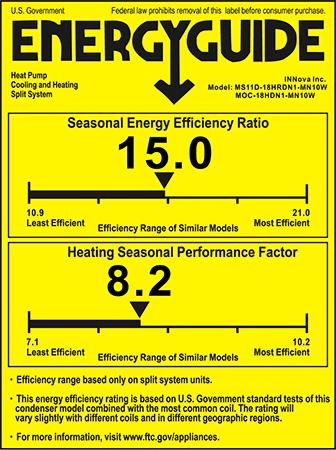
HSPF Quick Brief
| Rating | Meaning | Equipment Affected | Application | Description |
|---|---|---|---|---|
| HSPF | Heating Seasonal Performance Factor | Heat Pumps | Heating | Energy Efficiency |
What is HSPF?
So the good news is, if you already read our SEER article and understand what SEER is, then for the most part you already understand what HSPF is! HSPF is just like SEER, except instead of describing energy efficiency over a cooling season, HSPF focuses on energy efficiency during a heating season, therefore it's a ratio of heat energy output to electrical energy input, which means it only applies to heat pumps.
The Heating Seasonal Performance Factor (HSPF) is an efficiency rating required by the FTC (Federal Trade Commission) to be labeled on heat pump equipment. It was developed in 1979 with the help of the DOE (Department Of Energy), the AHRI (Air Conditioning, Heating, and Refrigeration Institute) and the ASHRAE (American Society of Heating, Refrigeration, and Air Conditioning Engineers) and is used to express a heat pump's energy efficiency during an average period of heating. HSPF only began to appear as a minimum efficiency standard in 1994.
HSPF only applies to Heat Pumps
HSPF only applies to heat pumps, which are basically air conditioners that have the added ability to heat a home as well as cool it down. That is to say, a heat pump can switch between transferring heat out of the home and cooling it down, or transferring heat into the home and heating it up, depending on if the thermostat is set to "HEAT" or "COOL".
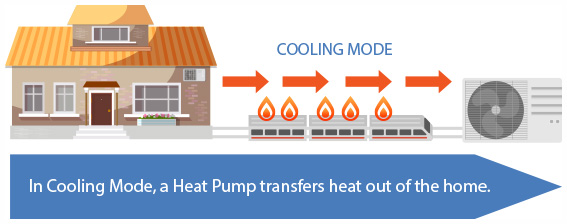
So, during the summer when a heat pump is switched into "COOL" mode at the thermostat, it functions as a regular air conditioner does, and cools the home down by transferring heat out of the home.
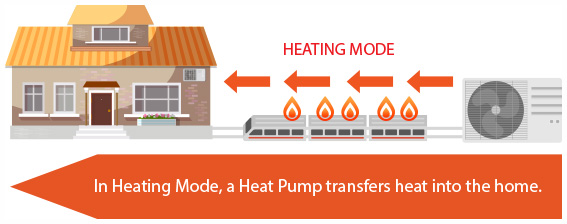
During the winter when a heat pump is switched into "HEAT" mode at the thermostat, instead of kicking on a furnace to heat the home, a special valve called a Reversing Valve inside the heat pump makes the refrigerant inside the heat pump flow in the opposite direction, which is what allows the heat pump to begin transferring heat into the home, which heats it up.
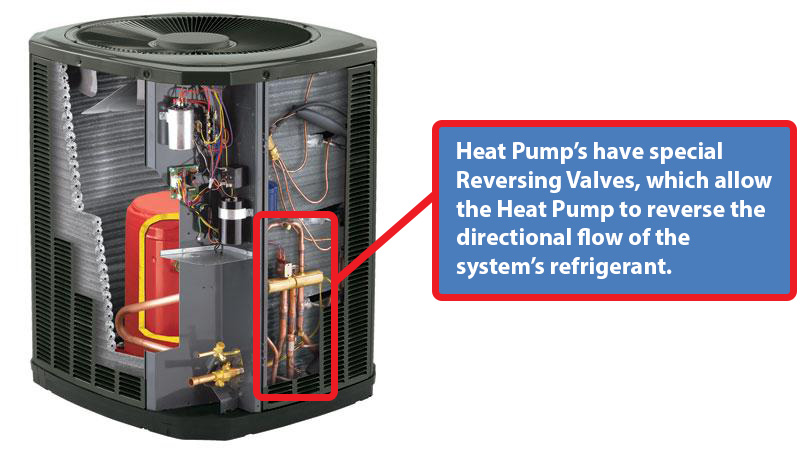
It looks like an air conditioner.. It sounds like an air conditioner.. It's a heat pump!
So, unlike a furnace, which creates it's own heat from a fuel source such as natural gas or electricity in order to heat up a home, a heat pump transfers heat into a home from the outdoors in the exact opposite way an air conditioner transfers heat out of a home to the outdoors.
This means, when the thermostat is set to "HEAT" with heat pump, the outside unit still turns on just as it traditionally does when the thermostat is set to "COOL", but instead of cooling the home, the heat pump heats the home, and it's all due to the fact that the refrigerant inside the system is flowing in the opposite direction, and therefore transferring heat into the home, thus warming it up.
"Ok, I get it.. It's an air conditioner that heats up a home.. But, what is HSPF?"
HSPF then, is SEER for a heat pump's heating mode during a heating season - The higher a heat pump's HSPF, the less energy the heat pump consumes in heating mode during a heating season. This means that when it comes to heat pumps, not only will you find an HSPF label stuck to the side of a heat pump, but a SEER label as well - The SEER describing the cooling efficiency of the heat pump during a cooling season, and HSPF describing the heating efficiency during a heating season.
Technically speaking, the Heating Seasonal Performance Factor (HSPF) of a heat pump is a ratio composed of the total heating output energy of heat pump during a heating season measured in BTUs, divided by the electrical input energy of the heat pump used during the same heating season expressed in Watt Hours.

So, just like SEER, it's important to note that heat pump HSPF is the result of tests and calculations performed inside of a laboratory setting that serves to simulate an averaged seasonal "heating" environment. This includes gathering heat pump performance data from tests conducted on heat pumps at a constant indoor temperature of 70°F, and at 3 separate outdoor temperatures, including: 47°F, 35°F, and 17°F over a period of time.
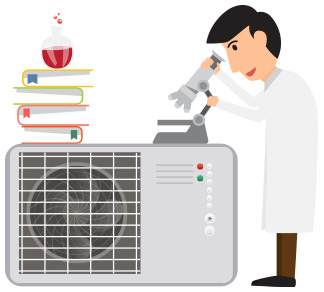
And, although the testing procedures performed within the laboratory are very controlled and very accurate, the results from the tests are further adjusted by factors that most likely aren't going to be the exact same when it comes to your own home. Which means - An HSPF label may or may not reflect the actual energy consumption of a heat pump installed in your own home (probably not).
So, HSPF is a bit more complicated than SEER, and SEER unfortunately isn't backwards compatible for a heat pump's heating efficiency even if we plug in different variables into the SEER formula - Even though the formulas look the same, the factors that adjust a heat pumps capacity and energy consumption are quite different from an air conditioner going through a cooling season. This is because heat pumps transfer heat out of a cold outdoor environment, into a home, and as we'll soon find out, things are a bit different when we try to transfer heat from an outdoor environment that is already very cold and contains very little usable heat for a heat pump to transfer.
Alright so now that we understand the HSPF label and it's limitations, how about we actually use one to calculate a 4 ton heat pump's seasonal energy heating costs during a heating period of 90 days where the heat pump is ran for 8 hours a day. Which is very similar in total heating hours to the winter climate zone Houston is classified under as Winter Climate Zone 1.
First, lets consider our heat pump to have 4 tons of maximum heating capacity. At 4-Tons of heating output capacity, our heat pump is capable of transferring a maximum of 48,000 BTUs of heat energy per hour, however, 4 ton heat pumps don't always run for an hour at a time, which means they don't always transfer 48,000 BTUs worth of energy every single hour. With that in mind, our scenario is assumed as follows:
Alright so our scenario is set up and all the variables we need to make a cost calculation are defined above.
So as we see, HSPF can be a tricky efficiency rating to understand and it definitely has it's limitations, but that's because there are so many variables involved with HSPF, and because HSPF is based on weather data that your location may or may not be apart of. This means HSPF is meant to be viewed as an average standard for the entire US to ensure standard efficiency across the US - Heat pump efficiency is definitely going to change at your location.
Today, modern heat pumps have a minimum HSPF rating of 8 to 8.2 HSPF depending on the location and type of heat pump equipment being installed, and a somewhere around a maximum of 14 HSPF as of 2017 based on modern technological limitations.
It is also important to note that HSPF evaluations are performed using an entire package of components which are all collectively tested at once in order to calculate an HSPF, and as a single system supplied by the manufacturer. Meaning, manufacturers that are having their system's HSPF evaluated supply 3 different pieces of equipment that are all used during a HSPF evaluation, including: An Outdoor Heat Pump Unit, a Furnace, and an Indoor Evaporator Coil - All 3 of which are all evaluated as a single system in order to calculate HSPF. This means, simply purchasing a new 13 HSPF heat pump and plugging it into your existing furnace and evaporator coil does not automatically upgrade the entire system to 13 HSPF.
How HSPF is evaluated.
"So, what all does an HSPF test consist of? Can't we just take the SEER rating and change it up a bit?"
Heat pumps also contain additional features that have to be factored into the HSPF calculation in order to properly represent energy consumption. These additional features simply aren't factored in to the SEER calculation because they are features that only Heat Pumps have. Not to mention, the winters across the United States are very different from one location to the next, and therefore so is heat pump energy consumption. So, in an attempt to make a generalized and averaged efficiency standard for heat pump equipment to be tested against across the entire US, the HSPF calculation has become quite different from SEER.
Here's how it all works out:
HSPF evaluations are conducted in the same way other AHRI efficiency evaluations are - Heat Pump's for which an HSPF rating is going to be determined are set up inside a laboratory setting consisting of 2 side by side rooms.
Due to the fact that heat pumps transfer heat from an outdoor environment, into an indoor environment, one of the rooms in the laboratory simulates an outdoor environment, while the other room simulates an indoor environment.
For the most common types of heat pump systems, which include systems that use a single speed compressor and a forced air furnace that delivers a constant volume of air, 3 separate tests are performed where the outdoor testing environment's temperature changes while the indoor testing environment's temperature remains the same, as shown below:
HSPF Test 1
The simulated outdoor environment, which contains the outdoor heat pump unit, is maintained at 47°F.
HSPF Test 2
The simulated outdoor environment, which contains the outdoor heat pump unit, is maintained at 35°F.
HSPF Test 3
The simulated outdoor environment, which contains the outdoor heat pump unit, is maintained at 17°F.
The heat pump equipment is then operated in heat mode within these simulated indoor and outdoor conditions as described above, and over the course of time the energy consumption and heating output capacity of the equipment is monitored, and logged as a series EER (Energy Efficiency Ratio) values.
Now, this is the part where HSPF begins to get interesting - Winter temperatures can vary greatly depending on where you are in the United States, more importantly when it comes to heat pumps, the number of hours at which the outdoor temperature drops to a temperature that is near or below freezing varies greatly depending on where you are in the United States.
As it turns out, the outdoor temperature is pretty important when it comes to a heat pumps ability to heat up a home, because heat pumps absorb heat from a cold outdoor environment and pump that heat into a home. This means, the colder the outdoor temperature, the less heat it contains, and therefore the harder it is for a heat pump to absorb heat out of this cold environment. So, the outdoor temperature plays an big role in how effective a heat pump actually is, because it can get quite difficult for a heat pump to extract heat from an outdoor environment where the temperature is close to, or below freezing.
"Wait a minute.. So what happens to a heat pump when the outdoor temperature drops near or below freezing, again? Does it just stop working? Or?"
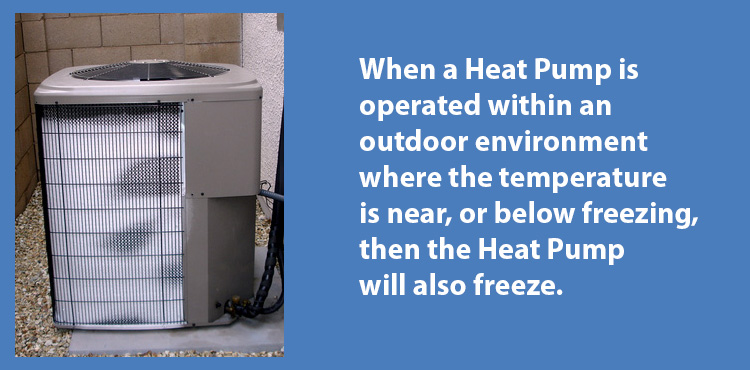
When a heat pump is operated within an outdoor environment where the temperature is near or below freezing, the heat pump will also freeze.
Let's think about how a heat pump works for a moment so we can picture this happening: A heat pump transfers heat from the outdoor environment, into the indoor environment. The laws of thermodynamics (Heat Laws) tell us that heat travels from something that is hot, to something that is cold, in an attempt to equalize temperature. Well, if the outdoor environment is near or below freezing and contains very little heat (not enough to keep Humans comfortable anyway), then in order for a heat pump to absorb the heat out of an already-freezing outdoor environment, the heat pump must in-fact get colder than the outdoor environment in order for the heat transfer process to take place - Because Hot goes to Cold, remember? Which means, if the outdoor environment is already near or below freezing temperatures, and the heat pump has to get colder than the outdoor environment, then the heat pump freezes as well.
Because a heat pump will freeze-up and accumulate ice on the outside unit when the outdoor temperature drops near or below freezing (Such as during the 35°F and 17°F tests performed during HSPF evaluations), and since a heat pump cannot operate correctly while it is frozen, a heat pump will periodically enter a "defrost cycle" in order to thaw, so it can continue to transfer heat into a home.
During a heat pump's defrost cycle, the heat pump essentially shuts down in order to defrost, and during this down-time the system temporarily activates a back-up heating method in order to continue to supply heat to the home while the outdoor unit attempts to thaw. This back-up heating method typically includes activating a series of electrical heat strips inside an electric air handler (forced air furnace) within the home in order to continually heat the home while the outdoor unit thaws.
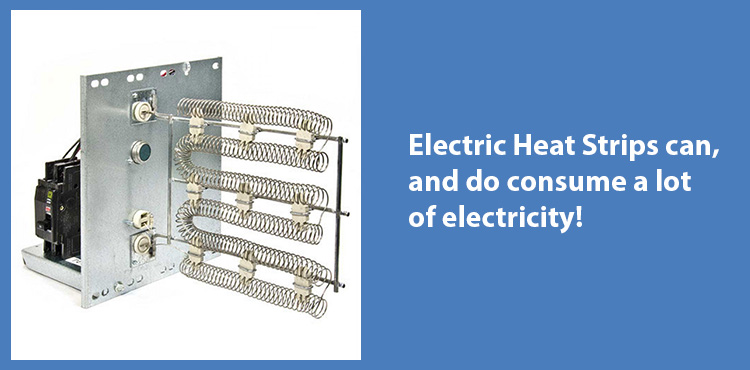
Since the electrical heat strips that are activated during a heat pumps defrost cycle in order to heat the home while the outdoor unit is defrosting consume a lot of energy, and often more energy than the heat pump, this extra energy consumption is factored into the HSPF calculation so consumers are not mislead by a heat pump's efficiency rating. This means that, during a heat pump's HSPF evaluation, the energy consumption and run time from this back-up heating method that takes place during a heat pump's defrost cycle is monitored, gathered and then added to the Watt Hours of energy consumption variable in the HSPF formula.

This means, defrost cycle energy consumption is extremely important when it comes to calculating your heat pumps energy efficiency - The more often heat pump enters it's defrost cycle, the more often it kicks-in it's inefficient back-up electric heat strips in order to keep your home from getting cold, and the higher your electric bill becomes from running these inefficient electric heat strips.
Unfortunately, the rate at which a heat pump enters it's defrost cycle depends on how cold the outdoor temperature is, which varies by location - Some areas of the United States simply have colder winters with colder outdoor temperatures, which means heat pump energy consumption is also going to vary by location.
This "freezing factor", and the fact that it varies by location, has caused the HSPF calculation to multiply heat pump energy consumption and a heat pump's back up heating energy consumption, against averaged weather data collected across the United States, which has essentially split the US into 6 winter climate zones (Not to be confused with the DOE's minimum standard efficiency zones). These 6 zones are essentially split up by winter weather data indicating how many hours of heating load run-time on average the zone experiences for the entire year.
Now, using a climate zone to reflect energy consumption is a great concept, but the issue is, regardless of what climate zone you are located within, when it comes to the actual FTC published data that's printed on the HSPF label that comes stuck to the side of a heat pump, only one zone's data is actually used - Zone 4, which may or may not be the zone your home is located within. This means even if you're considering a heat pump's energy efficiency in Houston, which is apart of Zone 1 (See below), the weather data that is factored into the heat pump's HSPF is actually based off of data that occurred in climate Zone 4 (See below).
Let's go ahead and look at the 6 different climate zones, their total heating load run time hours for the year, as well as how these run time hours are broken down by temperature:
Total Heating Hours by Zone
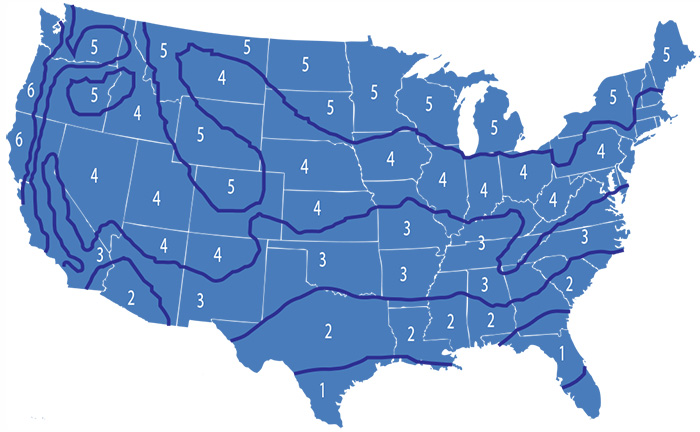
Zone
Total Heating Load Hours
1
750
2
1250
3
1750
4
2250
5
2750
6
2750
Temperature Hours Per Zone
Temperature
Zone 1 Hours
Zone 2 Hours
Zone 3 Hours
Zone 4 Hours
Zone 5 Hours
Zone 6 Hours
62°F
218.25
268.75
267.75
297
291.5
310.75
57°F
179.25
236.25
248.50
249.75
253
566.50
52°F
145.50
203.75
241.50
231.75
236.50
591.25
47°F
96.75
178.75
239.75
209.25
209
561
42°F
60.75
140
236.25
225
214.50
387.75
37°F
30.75
110
206.5
245.25
239.25
209
32°F
14.25
70
161
283.50
280.50
93.50
27°F
3.75
30
73.50
195.75
258.50
22
22°F
.75
10
36.75
123.75
203.50
8.25
17°F
-
2.5
15.75
81
151.25
-
12°F
-
-
8.75
58.5
129.25
-
7°F
-
-
3.50
29.25
104.50
-
2°F
-
-
1.75
13.50
79.75
-
-3°F
-
-
-
4.50
49.50
-
-8°F
-
-
-
2.25
27.5
-
-13°F
-
-
-
-
13.75
-
-18°F
-
-
-
-
5.50
-
-23°F
-
-
-
-
2.75
-
So, using the weather data above: After the 3 performance tests are performed and the heat pumps heating output capacity and energy consumption are gathered from each test, and after the heat pump's back-up energy consumption and run time is determined and added to the HSPF equation, all of this data is then multiplied by Climate Zone 4's weather data depending on the temperature - The heat pumps energy consumption gets multiplied by the total heating run-time hours for the entire zone, while the back-up heating method's energy consumption only gets multiplied by the hours at which the temperature dropped below 37°F.
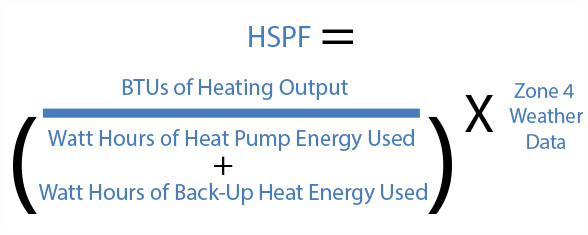
This essentially forms the total BTU heating output capacity and the total Watt Hours worth of energy consumed for the heat pump across the entire heating season, which is exactly what the HSPF formula is. That is to say, we now have our total BTUs of heating output for the season, and the total Watt Hours of energy consumption used for the season, however, the calculation isn't complete yet, as it now needs to be adjusted.

So now, the total BTU heating output from the heat pump for the season, and the total Watt Hours worth of energy consumption the heat pump used for the season, both need to be adjusted in order to reflect certain concepts that affect these things in real life, including: Internal heat gains, and equipment on/off cycling. This includes multiplying the heating output capacity and the electrical energy consumption by a correction factor, as well as a partial load factor.

The Correction Factor adjusts the heating output capacity as well as the energy consumption based on the fact that a home also experiences heat gains that are separate from the heat being provided by the heat pump. That is to say, the number of people inside the home, their activities (such as cooking, bathing, etc), their electronics, their appliances, as well as heat from the sun all add heat to the inside of a home, and this heat is technically separate from the heat provided by the heat pump. Which means, this internal heat affects the heat pump's performance, because it's essentially heat that doesn't have to be added to the home by the heat pump in order to reach the thermostat's set point, which will lower the heat pumps run time, and therefore it's energy consumption. The AHRI test uses a Corrections Factor of 0.77, which essentially drops the heat pumps performance by a total of 23% to account for average internal heat gains.
Once the correction factor has been applied to the HSPF, the HSPF is then multiplied by the Partial Load Factor, which you may remember from our SEER calculation.

The Partial Load Factor serves to adjust heating output capacity and energy consumption for heat pump equipment based on the fact that heat pumps often cycle on and off over periods of time as they transfer heat into a home. For example, a homeowner may own a heat pump that is capable of transferring 48,000 BTUs of heat per hour to the inside of the home, however, 48,000 BTUs of heat may not actually be needed to reach the set point on the thermostat, which means the heat pump will not run for an entire hour in order to reach the thermostat's set point, and thus the system will cycle off before actually transferring it's full load of 48,000 BTUs per hour. PLF then, is a multiplier that adjusts energy consumption to account for this on/off behavior before a full load of heating output capacity has been transfered into the home. The partial load factor, just like the correction factor, once again lowers the season's total BTU output capacity and it's Watt Hours worth of energy consumption.
When it comes to PLF, equipment manufacturers that are having their HSPF calculated may either run an optional test to determine this PLF value, or use the AHRI's default PLF value of 0.75 - Which ever value is lowest will be used. If the default value of 0.75 is used, the heat pumps performance is essentially reduced by 25%, so it is assumed that most manufacturers do test for this value in an attempts to score a higher HSPF, however, PLF data and machine performance data is not made available to the public, so we must assume it is somewhere at or below the default value of 0.75.
At this point, the HSPF calculation is essentially complete, and to quickly sum up what has taken place: The heating output capacity and energy consumption gathered from the 3 performance tests, as well as the energy consumption and run time gathered from the heat pump's back-up heating method, have all been multiplied against the weather data from winter climate zone 4, and then adjusted against an internal heat gains correction factor, as well as a partial load factor. This data is then inserted into the HSPF formula, and the formula is then expressed as an HSPF value.
"Wait a minute, this makes no sense! I don't live in Winter Climate Zone 4! Why on Earth should I base my heat pumps energy efficiency off of it?"
Right. So as you may have noticed, between the 6 different climate zones heating load run-time hours can vary greatly, however, as mentioned earlier, all HSPF's are labeled according to winter climate zone 4's weather data. This is important to point out, because actual run time hours as well as defrost cycle hours vary greatly depending on which zone you're actually located within, and therefore so does heat pump energy consumption - The more often a heat pump is ran in an outdoor environment with a temperature near or below freezing, the more often a heat pump will freeze, the longer it will take to thaw, and therefore, the more often it will have activate it's inefficient back-up heating methods.
So if your located in Houston, but your heat pumps HSPF is based off weather data from winter climate zone 4, what do you do?
For example, here in Houston the outdoor temperature may rarely fall to the 37°F and below, which is what HSPF defrost cycle run-time and energy consumption is calculated against, and according to the data above, within Climate Zone 1 where Houston is located, Houston has 49 hours and 30 minutes worth of heating load hours where the temperature actually falls to or below 37°F. This means that in Houston, a heat pump rarely enters a defrost cycle. This fact alone greatly increases a heat pumps energy efficiency in Zone 1, however, it's not what is actually printed on the label since all HSPF labels are published against Climate Zone 4's weather data and run-time hours.
Just to emphasize this, let us compare Zone 1's weather data to Zone 4's: If we add up the total number of hours a heat pump is operated at or below 37°F using Climate Zone 4's weather data, the total comes to 1,282 Hours and 30 minutes - That's a huge difference between Houston's (Zone 1's) 49 Hours and 30 minutes.
This fact alone speaks volumes on how we as consumers are to approach the usefulness of HSPF, and it makes it very apparent that it was never intended to be site-specific, because it doesn't require that each zone reflect it's actual weather data on equipment within that zone. This means HSPF is meant to be viewed as an averaged standard, it exists as an average so manufacturers produce something that is going to perform well on average across the United States - It's not intended to be site specific, so we shouldn't view it as though it is.
Fortunately, this is a problem the energy department is well aware of, unfortunately it's not something the public is generally aware of. So the EIA (Energy Information Administration), which is part of the DOE, has created a spreadsheet for consumers to convert a heat pump's labeled HSPF into an HSPF that reflects the actual weather data in their climate zone, which can be found here:
Climate Zone Spreadsheet
This means, it's very important to know the climate your dealing with when it comes to heat pumps. The spreadsheet is useful, but it doesn't account for the variables that are unique to your specific home, which is something you and your contractor should always consider when picking out a heat pump. Therefore, HSPF may be useful as an average efficiency rating to go by for the entire nation, but when it comes to your specific home, and your specific expectations of energy savings and comfort, no average efficiency rating is absolute and nothing compares to having hands-on knowledge and experience with your specific home, your specific climate, and hands on experience with heat pumps.
So if a heat pump is something your interested in for your home, make sure you work with your contractor and combine efforts to come up with the best solution. With the combined knowledge of your home and the contractors experience with providing heat pump solutions in your local area, a contractor can help you select a heat pump that will meet your comfort needs, and work efficiently within your winter climate.
Using HSPF to calculate energy cost.
"So, how can I calculate the cost of a heat pump's energy consumption using it's HSPF?"
If we recall with the HSPF formula mentioned earlier, HSPF is equal to the heating output capacity measured in BTUs over the course of a heating season, divided by the input of electrical energy in Watt-Hours during that same heating season, or:

Let's go ahead and set up a heat pump scenario and fill in these variables that make up our HSPF formula so we can begin the energy cost calculation:
Assume the heating season for which we will be calculating the energy cost of running our heat pump within is exactly 90 days long.
Assume the heat pump being operated through this heating season is a 4 Ton heat pump (48,000 BTU/H of Total Cooling Capacity).
Assume the 4 ton heat pump runs at an average of 8 hours per day during our cooling season.
Assume the 4 ton heat pump runs at an average of two thirds it's total BTU heating output capacity.
Assume the 4 ton heat pump is rated at 9 HSPF.
Assume the price of energy from the electric company is $0.11 cents per Kilowatt Hour worth of energy consumed.
Now, the first thing we need to do is determine what two thirds of 4 tons is, because if we recall from our scenario above, our heat pump is running at an average of 2/3 it's total heating output capacity.
If a ton of heating capacity is equal to 12,000 BTUs per Hour, and we have a 4 ton heat pump, then 4 tons is equal to 48,000 BTUs per hour. So what is two thirds of 48,000? We can find out simply by multiplying our maximum available heating capacity of 48,000 BTU/H by two thirds:

With our actual and modified heating output capacity of 32,000 BTUs per hour, we now need to figure out how many BTUs we use over the course of 8 hours, because if you remember from our above scenario, we are operating our heat pump for a total of 8 hours per day. This can be achieved by multiplying our actual BTUs per hour, by 8 Hours, as follows:

So by running our heat pump for 8 hours a day, we come out to a total of 256,000 BTUs of heat transfered per day. We now need to multiply this daily value by our 90 day season in order to find out how many BTUs our heat pump will transfer over the course of our 90 day heating season, which we can calculate by multiplying our daily transfer rate of 256,000 BTUs per day by 90 days, as shown below:

Nice. So, we now have calculated how many BTUs worth of heat our heat pump will transfer over the course of our 90 day heating season and that means we have officially calculated half of our equation.
Now we need to figure out how much electrical energy in Watt-Hours this entire load will consume. This can be calculated by simply dividing our the 90 day season's BTUs of heating capacity by our Heat Pump's HSPF of 9, like so:

Alright, so in order for our 9 HSPF heat pump to transfer 23,040,000 BTUs worth of heat during our 90 day season, it will consume around 2,560,000 Watt-Hours worth of electrical energy consumption.
The next step is to figure out how much the electric company is going to charge us to consume all this electrical energy over the course of our 90 day heating season, but right off the bat we have a problem - Electric companies don't bill us based on Watt-Hours worth of energy consumption, they bill us based on Kilowatt Hours worth of energy consumption. So, let's go ahead and convert our 90 energy consumption of 2,560,000 Watt-Hours into Kilowatt Hours.
Since Kilowatts are simply units consisting of 1000 watts, in order to convert Watt-Hours to Kilowatt Hours all we have to do is divide our rough number of Watt-Hours by 1000, as shown below:

Awesome! So we now have our heat pumps 90 day seasonal Watt-Hours worth of energy used converted into Kilowatt Hours worth of energy used. Now, how about now we convert all of this electrical energy usage directly into a total cost? This can easily be achieved by multiplying our total Kilowatt Hours worth of energy consumed for this cooling season, by the cost the electric company charges us for each Kilowatt Hour worth of energy we use. As mentioned earlier, in this scenario the electric company charges us $0.11 cents per Kilowatt Hour worth of energy we use, which makes our total come out to:

Alright, so if we're paying $0.11 cents per Kilowatt Hour of energy consumption, our total comes out to $281.60 dollars for the entire 90 day heating season! Not too bad..
And, that is how it is done! Remember: It's important to keep in mind that we assumed so much in our calculations, and so does the HSPF evaluation at the lab where the HSPF for the heat pump was determined, that this most likely isn't going to be what we end up paying after 90 days of operation with a 4 Ton 9 HSPF Heat Pump, even if we operate our Heat Pump in the same way that we defined in our scenario - There's still just too many variables involved that we simply can't account for.
Remember, just about every little thing that goes on inside of (and outside of) your home contributes to it's heat load, which contributes to your heat pump's energy consumption, and these are factors that simply aren't factored into our calculations or the laboratory's calculations when they evaluate a heat pumps HSPF. Factors including everything from: The actual outdoor temperature during your heating season; How clean your air filters are; How many people are in your home and the length of time they are in your home; How many windows your home has and which cardinal direction they face; How well your home is insulated; What type of light bulbs your home has and how much heat they put off; How often you run your appliances; And even how often you shower - Every little thing contributes to the amount of heat inside of your home, and these are factors that affect how long your heat pump is going to operate.
Final Thoughts on HSPF
This means, HSPF is just a tool - A single perspective to view a heat pump's energy consumption from as it's based against national weather data. HSPF labels exist for comparison purposes only, and are regulated by law so consumers can compare products on an equal playing field against a national bin of averaged weather data. There are other Heat Pump efficiency ratings, such as COP (Which we will discuss after this article), which we should also evaluate when we think about purchasing a heat pump.
If we really wish to consider a heat pump's efficiency and usefulness at our own home, then we should always consult our own knowledge of the weather data in our current location as well as our own knowledge of our own home's construction and internal heat gains - There are so many unique factors involved with every single home that simply aren't apart of any heat pump's HSPF evaluation.
Keep in mind that: A heat pump is most efficient in a location where the outdoor environment doesn't freeze, so if your specific area of the US happens to drop near or below freezing for a large portion of a heating season, you may find yourself operating the heat pump's back-up heating method more often than not, which may translate into a very high electric bill.
Heat Pumps use electricity: Many times selecting a heat pump comes down to what resources are available at the install location, and the price of those resources - Some homes have access to natural gas, while some homes only have access to electricity and propane, and often this is the main deciding factor when it comes to installing heat pumps. For example, is natural gas available at your home? If so, is using a forced air furnace that burns natural gas in order to heat up your home going to cost more or less than operating a heat pump and paying the heat pump's electricity bill?

